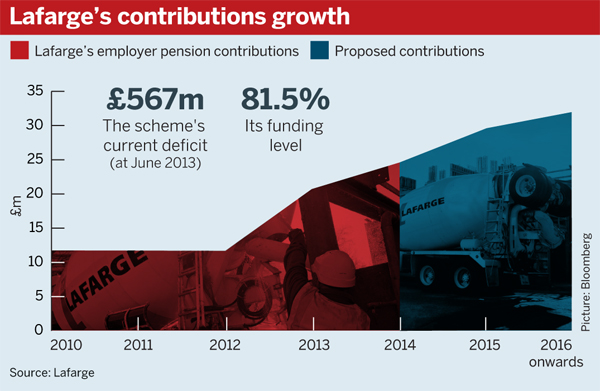Building materials manufacturer Lafarge has more than doubled its contributions to its UK pension fund after scheme and sponsor negotiated a beefed-up recovery plan to tackle the funding deficit.
Despite the gradual recovery in the economy, actuarial consultants have reported that many sponsors of defined benefit schemes are maintaining rather than raising the level of their funding payments.
Under the 15-year agreement secured last month, when the scheme finalised its June 2012 valuation, Lafarge UK Pension Plan will receive payments from its sponsor of £25m by December 31 2014, £30m in 2015 and £32.5m from 2016 onwards, according to scheme documents.
This is an increase from annual employer contributions of £21.3m made to the scheme in 2013 and £12m made from 2010 until 2012, which were agreed at its last triennial review in 2009.

“From the 2009 to 2012 valuation [the deficit] remained fairly constant so there was a need to demonstrate that we were seeking further contributions over and above to help close that gap,” said head of UK pensions and trustee secretary Richard Harris.
The scheme’s deficit stood at £660m at June 30 2012, up from £614m at the same date in 2009. However, it had dropped to £567m at June 30 2013, increasing the scheme’s funding level to 81.5 per cent. The scheme’s March newsletter stated this is due to improvements in financial markets and stable liabilities.
The scheme agreed an extension of its timetable for completing its 2012 valuation with the Pensions Regulator, which closely monitored its progress, the newsletter revealed.
Annual payments may be increased to £36m from 2016 onwards, subject to Lafarge reattaining investment grade status, according to the scheme’s March 2014 newsletter.
The company most recently obtained a BB+ credit rating from Standard & Poor’s in November of last year.
Late last week the French company was reported by Bloomberg to be in merger talks with Swiss cement maker Holcim.
Simon Kew, director of pensions at covenant advisers Jackal Advisory, said there had not been a wider trend of schemes securing increased employer contributions, as employers often did not have the money.
For schemes that are renegotiating employer support, there tends to be a time lag between the economy picking up and an increase in employer contributions being made to schemes, he added.
“What’s important for the trustee to do is not put their foot on the neck of the employer now, when the employer does need to invest in the company,” said Kew.
The regulator recently introduced its employer growth objective, stating it will consider the impact on employers’ sustainable growth plans alongside members in its approach to DB funding.
Russell Agius, consultant at Aon Hewitt, agreed many sponsors do not have sufficient funds to make additional payments to their schemes.
“Some people are saying, ‘Look, we are already paying the absolute maximum that we can pay – there is no more money in the kitty’,” said Agius.
Trustees and employers could also consider some non-cash alternatives to reduce their deficits, said Agius.
These could include using contingent assets, Pension Protection Fund guarantees and reviewing the prudence of their assumptions – such as considering how much cash members are likely to take at retirement.














